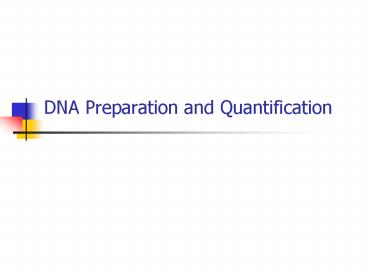DNA Preparation and Quantification - PowerPoint PPT Presentation
1 / 26
Title:
DNA Preparation and Quantification
Description:
Cells were transferred to a Chelex solution. ... Anneal Primers 60oC for 1 min. Extend 72oC for 2 min. Final extension at 72oC for 10 min. ... – PowerPoint PPT presentation
Number of Views:814
Avg rating:3.0/5.0
Title: DNA Preparation and Quantification
1
DNA Preparation and Quantification
2
Outline for Todays Lecture
- Results of Laboratory
- Sample Preparation Protocols
- DNA Quantification Procedures
3
I. Alu Insert at PV92
- Cheek Cell DNA Template Preparation
- Hair Follicle DNA Template Preparation
- PCR Amplification
- Gel Electrophoresis of Amplified PCR Samples
- Analysis and Interpretation of Results
4
1. Cheek Cell DNA Template Preparation
- Cheek cells were obtained by vigorously rinsing
your mouths with 0.9 saline solution and
collected by centrifugation. - Cells were transferred to a Chelex solution.
Chelex is negatively charged microscopic beads
that chelate metal ions such as Mg
5
Template Preparation contd
- The isolated cheek cells in Chelex are heated to
56oC to inactivate enzymes that can degrade the
DNA. This temperature also helps soften the cell
membrane and break up aggregates of cells. - The cells are then heated to boiling to lyse the
cells.
6
2. Hair Follicle DNA Template Preparation
- The procedure begins by obtaining two hairs with
an obvious sheath or a large root. - The hair is transferred to a tube containing
Chelex with protease added. The protease digests
the connections between the cells and facilitates
lysing of the cells.
7
3. PCR Amplification
- Centrifuge to collect chelex and cell debris in
the pellet. DNA will be in the supernatant. - Add DNA template to PCR reaction master mix.
- Place tubes in PCR thermal cycler to undergo 40
cycles of PCR amplification.
8
PCR Amplification contd
- Pre-denaturation at 94oC for 2 min.
- Amplification
- Denature 94oC for 1 min.
- Anneal Primers 60oC for 1 min.
- Extend 72oC for 2 min.
- Final extension at 72oC for 10 min.
- Hold at 4oC
9
Agarose Gel Electrophoresis of PCR Samples
- Prepared 1 Agarose gel
- 10 mL of PCR Sample 2 mL of Loading dye was
loaded onto agarose gel. - Applied voltage for at least 30 minutes to
resolve DNA fragments. - Photodocument gels
10
5. Analysis and Interpretation of Results
- MM 1 2 3 4
5 - /- / -/-
/- -/- - 1000
- 700
- 500
- 200
11
Analysis and Interpretation of Results
- MM 1 2 3 4
5
12
Analysis and Interpretation of Results
- -/- /- / 1 2 3 MM
13
II. Sample Preparation Protocols
- Organic DNA Extraction from Fresh Blood Samples
- Chelex Extraction of Whole Blood and Buccal
Cells - DNA Extraction Using FTA Paper
- QIAamp DNA Kits for DNA Isolation
14
FTA Paper from Whatman
15
FTA Paper from Whatman
16
III. DNA Quantification Procedures
- Absorbance at 260 nm
- Yield gel
- Slot Blot
- Picogreen Microtiter Plate Assay
17
Slot Blot Quantification
- Common Procedure
- Primate Specific
- Has been modified to use chemiluminesence rather
than radioactivity - Can detect subnanogram quantities
- Can detect d.s. and s.s. DNA
18
General Slot Blot Procedure
- Capture genomic DNA on a nylon membrane.
- Wash with a human specific labeled probe.
- Bind detection enzyme.
- Carry out colorimetric or chemiluminesence assay
and detection. - Compare with a set of standards.
19
Schematic of a Slot Blot
20
Slot Blot Quantification
- Uses only 5 mg DNA extract.
- Can detect 150 pg quantities ( 50 copies of
human genomic DNA). - Assay takes several hours.
- Detection takes between 15 minutes and 3 hours.
21
Slot Blot Advantages Disadvantages
- Can be sensitive
- Replaces radioactivity
- Can detect single stranded or partially degraded
DNA. - Quantity is of human DNA
- Labor Time Intensive
22
Picogreen Microtiter Plate Assay
- High Throughput Method
- 96-we microtiter plate format
- Can detect 0.25 ng/mL of double-stranded DNA.
- Detects double stranded DNA
- Uses a fluorescent interchelating dye.
- Can be performed in 30 minutes
- Quantifies using a standard curve.
23
PicoGreen Microtiter Plate Assay General
Procedural Outline
- Add 5 mL of sample to well.
- Add 195 mL of solution containing PicoGreen dye.
- Examine with a fluorometer.
- Quantify against a standard curve.
24
PicoGreen Microtiter Plate Assay Advantages
Disadvantages
- Can be automated
- Rapid results
- Sensitive
- Useful for PCR amplification of STR multiplexes
- Can detect only double stranded DNA
- Not specific for human DNA
25
Vocabulary
- Lysis
- Proteinase K
- DNase
- EDTA
- Chelex
- FTA paper
- Colorimeter Assay
- Chemiluminesence
- Interchelating
26
References
- Text Chapter 6
- Forensic DNA Profiling Protocols Edited by
Lincoln Thomson 1998 Humana Press, NJ - Forensic DNA Typing, Butler 2001 Academic Press
- fitzcoinc.com
- qiagen.com
- Bio_Rad.com































